Sistine Chapel
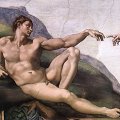 The Sistine Chapel (Cappella Sistina) is a chapel in
the Apostolic Palace, the official residence of the Pope, in the
Vatican City. Its fame rests on its architecture, which evokes the
Temple of the Old Testament, and its decoration, frescoed throughout
by the greatest Renaissance artists, including Michelangelo, whose ceiling is legendary. The Sistine Chapel is
considered to be the greatest artistic creation in the history
of mankind. Michelangelo could possibly be the greatest artist who has
ever lived. His paintings in Sistine Chapel, the triumph of
Renaissance humanist ideal, have changed the meaning of art
forever.
The Sistine Chapel (Cappella Sistina) is a chapel in
the Apostolic Palace, the official residence of the Pope, in the
Vatican City. Its fame rests on its architecture, which evokes the
Temple of the Old Testament, and its decoration, frescoed throughout
by the greatest Renaissance artists, including Michelangelo, whose ceiling is legendary. The Sistine Chapel is
considered to be the greatest artistic creation in the history
of mankind. Michelangelo could possibly be the greatest artist who has
ever lived. His paintings in Sistine Chapel, the triumph of
Renaissance humanist ideal, have changed the meaning of art
forever.
Book of Genesis
Michelangelo depicted nine scenes from the Book of Genesis, the first book of the Bible. Five of these are Creation stories. Closest to the door of the chapel is the drunkenness of Noah; God separating light from darkness is at the opposite end, closest to the altar. They were painted in this order, with Michelangelo said to have painted the last scene, the separation of light and darkness, in only one day. When viewing the frescoes in the chronological order of their creation, the increased freedom of composing and handling is apparent. They are designed to all appear the right way up when viewed from the sanctuary.
The Creation of Adam has an iconic standing equalled only by Da Vinci's Mona Lisa, the hands of God and Adam being reproduced in countless imitations.
- Sistine Chapel, Book of Genesis, The Separation of Light from Darkness (1511)
- Sistine Chapel, Book of Genesis, The Separation of Light from Darkness (Detail) (1511)
- Sistine Chapel, Book of Genesis, The Creation of the Sun, Moon, and Plants (1511)
- Sistine Chapel, Book of Genesis, The Creation of the Sun, Moon, and Plants (Detail) (1511)
- Sistine Chapel, Book of Genesis, The Creation of the Sun, Moon, and Plants (Detail 3) (1511)
- Sistine Chapel, Book of Genesis, The Separation of Land and Water (1511)
- Sistine Chapel, Book of Genesis, The Separation of Land and Water (Detail) (1511)
- Sistine Chapel, Book of Genesis, The Creation of Adam (1510)
- Sistine Chapel, Book of Genesis, The Creation of Adam (Detail) (1510)
- Sistine Chapel, Book of Genesis, The Creation of Adam (Detail 2) (1510)
- Sistine Chapel, Book of Genesis, The Creation of Adam (Detail 4) (1510)
- Sistine Chapel, Book of Genesis, The Creation of Eve (Detail) (1510)
- Sistine Chapel, Book of Genesis, The Fall and Expulsion from Garden of Eden (1510)
- Sistine Chapel, Book of Genesis, The Fall and Expulsion from Garden of Eden (Detail) (1510)
- Sistine Chapel, Book of Genesis, The Sacrifice of Noah (1509)
- Sistine Chapel, Book of Genesis, The Sacrifice of Noah (Detail) (1509)
- Sistine Chapel, Book of Genesis, The Sacrifice of Noah (Detail 2) (1509)
- Sistine Chapel, Book of Genesis, The Sacrifice of Noah (Detail 3) (1509)
- Sistine Chapel, Book of Genesis, The Flood (Detail 3) (1509)
- Sistine Chapel, Book of Genesis, Drunkenness of Noah (Detail) (1509)
- Sistine Chapel, Book of Genesis, Drunkenness of Noah (Detail 2) (1509)
- Sistine Chapel, Book of Genesis, Drunkenness of Noah (Detail 3) (1509)
The Separation of Light and Darkness
Sistine Chapel, Book of Genesis, The Separation of Light from Darkness (1511)
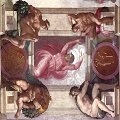 Get
Get  a high-quality picture of
Sistine Chapel, Book of Genesis, The Separation of Light from Darkness for your computer or notebook. ‣
The first scene in the chronological order of the narrative, The
Separation of Light from Darkness, is depicted in the centre of the
vault of the ninth bay.
a high-quality picture of
Sistine Chapel, Book of Genesis, The Separation of Light from Darkness for your computer or notebook. ‣
The first scene in the chronological order of the narrative, The
Separation of Light from Darkness, is depicted in the centre of the
vault of the ninth bay.
The beginning of the Creation is marked by the figure of God, seen from below, as he launches himself into infinite space with his arms raised, allowing spirals of light to sweep aside the darkness.
The poses of the four ignudi are very different from each other, without any attempt being made to obtain an effect of symmetry. Thus, the one above Jeremiah at the left, with a classical profile and a meditative attitude, contrasts sharply with the ungainly movement of the one the right, who laden with foliage and acorns, is throwing himself forward, his face in the shadow. On the opposite side, the two figures bend toward the centre, but with their torsos heads rotating in opposite directions with clearly distinct movements, splendidly rendered thanks to the artist's skilled use of perspective.
Above the cornices, the four ignudi bear medallions representing the Elijah ascending to Heaven on the Chariot of Fire (at left) and the Sacrifice of Isaac (at right).
Sistine Chapel, Book of Genesis, The Separation of Light from Darkness (Detail) (1511)
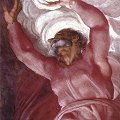 Get
Get  a high-quality picture of
Sistine Chapel, Book of Genesis, The Separation of Light from Darkness (Detail) for your computer or notebook. ‣
God, seen from below, launches himself into infinite space with his
arms raised, allowing spirals of light to sweep aside the
darkness.
a high-quality picture of
Sistine Chapel, Book of Genesis, The Separation of Light from Darkness (Detail) for your computer or notebook. ‣
God, seen from below, launches himself into infinite space with his
arms raised, allowing spirals of light to sweep aside the
darkness.
The Creation of the Sun, Moon, and Plants
Sistine Chapel, Book of Genesis, The Creation of the Sun, Moon, and Plants (1511)
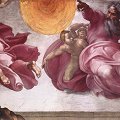 Get
Get  a high-quality picture of
Sistine Chapel, Book of Genesis, The Creation of the Sun, Moon, and Plants for your computer or notebook. ‣
The second scene in the chronological order of the narrative, the
Creation of the Sun, Moon, and Plants, is depicted in the large field
of the vault of the eighth bay, between the triangular spandrels.
a high-quality picture of
Sistine Chapel, Book of Genesis, The Creation of the Sun, Moon, and Plants for your computer or notebook. ‣
The second scene in the chronological order of the narrative, the
Creation of the Sun, Moon, and Plants, is depicted in the large field
of the vault of the eighth bay, between the triangular spandrels.
In this scene the figure of the Lord appears twice: on the right, as he is about to give shape, with his outstretched arms, to the incandescent disk of the sun and the cold one of the moon; and, on the other side, as, with an imperious gesture, he summons forth tufts of grass and the first bushes from the bare earth. The scene is divided unequally: the great disk of the sun - the only element of colour that stands out clearly from the more subdued tones of the clothes, flesh, and the greyish white background of the sky - is to the left of the central axis of the field, and the whole of the right part is dominated by the figure of the Creator who, surrounded by four children, moves impetuously toward the viewer.
On the left, in a more restricted field, and further back from the picture plane, the Creator is depicted once again - notably foreshortened and seen from behind - as he heads toward the earth, going away from the foreground. Together with the strong contrasts of light and shade, the movement in opposite directions of the two figures heightens the dynamic tension of the scene and conveys a sense of immediacy.
Sistine Chapel, Book of Genesis, The Creation of the Sun, Moon, and Plants (Detail) (1511)
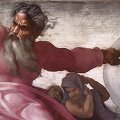 Get
Get  a high-quality picture of
Sistine Chapel, Book of Genesis, The Creation of the Sun, Moon, and Plants (Detail) for your computer or notebook. ‣
The right part of the scene is dominated by the figure of the
Creator who, surrounded by four children, moves impetuously toward the
viewer.
a high-quality picture of
Sistine Chapel, Book of Genesis, The Creation of the Sun, Moon, and Plants (Detail) for your computer or notebook. ‣
The right part of the scene is dominated by the figure of the
Creator who, surrounded by four children, moves impetuously toward the
viewer.
Sistine Chapel, Book of Genesis, The Creation of the Sun, Moon, and Plants (Detail 3) (1511)
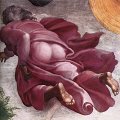 Get
Get  a high-quality picture of
Sistine Chapel, Book of Genesis, The Creation of the Sun, Moon, and Plants (Detail 3) for your computer or notebook. ‣
On the left, in a more restricted field, and further back from the
picture plane, the Creator is depicted once again - notably
foreshortened and seen from behind - as he heads toward the earth,
going away from the foreground. Together with the strong contrasts of
light and shade, the movement in opposite directions of the two
figures heightens the dynamic tension of the scene and conveys a sense
of immediacy.
a high-quality picture of
Sistine Chapel, Book of Genesis, The Creation of the Sun, Moon, and Plants (Detail 3) for your computer or notebook. ‣
On the left, in a more restricted field, and further back from the
picture plane, the Creator is depicted once again - notably
foreshortened and seen from behind - as he heads toward the earth,
going away from the foreground. Together with the strong contrasts of
light and shade, the movement in opposite directions of the two
figures heightens the dynamic tension of the scene and conveys a sense
of immediacy.
The Separation of Land and Water
Sistine Chapel, Book of Genesis, The Separation of Land and Water (1511)
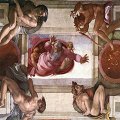 Get
Get  a high-quality picture of
Sistine Chapel, Book of Genesis, The Separation of Land and Water for your computer or notebook. ‣
The third scene in the chronological order of the narrative, the
Separation of the Earth from the Waters, is depicted in the centre of
the vault of the seventh bay, between two pairs of ignudi with
medallions.
a high-quality picture of
Sistine Chapel, Book of Genesis, The Separation of Land and Water for your computer or notebook. ‣
The third scene in the chronological order of the narrative, the
Separation of the Earth from the Waters, is depicted in the centre of
the vault of the seventh bay, between two pairs of ignudi with
medallions.
The last three scenes painted by Michelangelo in the centre of the vault evidently form a triptych representing the Creation. Proceeding toward the altar wall, the artist first frescoed the scene of the Separation of the Earth from the Waters; then - in one of the largest panels - the double scene generally known as the Creation of the Sun, Moon, and the Plants; and lastly, the Separation of Light from Darkness. Naturally, the chronological sequence start from the last of the above-mentioned scenes, which begins the account in Genesis. However, the events depicted immediately after this refer to the third and fourth days of the Creation, while the Separation of the Earth from the Waters took place at the beginning of the second day. The failure to respect the chronological order was probably dictated by the need to reserve the field of the largest panel for the scene that required most space for its representation.
In the Separation of the Earth from the Waters the Lord flies over the gray-blue expanse of the waters, soaring aloft in his large billowing mantle together with his retinue of angels. His notably foreshortened figure seems to be launched from the left toward the viewer. Behind the Creator, the sky is clear and bright, while his other side it has turned grayish-white.
The poses of the pairs of ignudi become gradually more dynamic and agitated. The two above the Persian Sibyl (at the left) bend backward in opposite directions, while one of those above the prophet Daniel (at right) bends forward, casting an apprehensive glance at the viewer, and the other raises his arm in a movement reminiscent of Hellenistic sculptures of dancing fauns.
One of the medallions is not decorated, the other represents the Death of Absolom.
Sistine Chapel, Book of Genesis, The Separation of Land and Water (Detail) (1511)
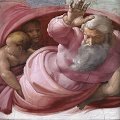 Get
Get  a high-quality picture of
Sistine Chapel, Book of Genesis, The Separation of Land and Water (Detail) for your computer or notebook. ‣
"And God said, Let the waters under the heaven be gathered together
unto one place, and let the dry land appear: and it was so. And God
called the dry land Earth; and the gathering together of the waters
called he Seas." (Genesis 1:9-10)
a high-quality picture of
Sistine Chapel, Book of Genesis, The Separation of Land and Water (Detail) for your computer or notebook. ‣
"And God said, Let the waters under the heaven be gathered together
unto one place, and let the dry land appear: and it was so. And God
called the dry land Earth; and the gathering together of the waters
called he Seas." (Genesis 1:9-10)
The foreshortened figure of the Lord is described by Vasari: "He is seen flying on the vault, a foreshortened figure which continually turns and changes direction as you walk through the chapel."
The Creation of Adam
Sistine Chapel, Book of Genesis, The Creation of Adam (1510)
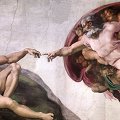 Get
Get  a high-quality picture of
Sistine Chapel, Book of Genesis, The Creation of Adam for your computer or notebook. ‣
The fourth scene in the chronological order of the narrative, the
Creation of Adam, is depicted in the large field of the vault of the
sixth bay, between the triangular spandrels.
a high-quality picture of
Sistine Chapel, Book of Genesis, The Creation of Adam for your computer or notebook. ‣
The fourth scene in the chronological order of the narrative, the
Creation of Adam, is depicted in the large field of the vault of the
sixth bay, between the triangular spandrels.
Michelangelo's organization of the Sistine ceiling frescos represents perhaps the most complex composition in Western art. The space contains an intricate pseudo structure of architecture that frames the sculpture-like forms. Out of the nine narrative scenes depicting events from Genesis, the most sublime scene is this "Creation of Adam," in which his new vision of humanity attains pictural form.
It is scarcely possible to put into words the impressions roused by this marvellous painting; it is as though current passed from the painted scene to the beholder, who often feels that he is assisting at a hallowed world-shaking event. Michelangelo experiences the stages of creation within himself, retracing the way to the divine source by the double path of religion and of art. Now that, inspired by God, he has given form to Eve, elliptical and parabolic shapes begin to multiply; the number of orbits with two focal points increase. These were copied blindly during the following two centuries and became a decorative commonplace.
Precisely here, where man the microcosm and incarnate Word made in the divine image, the Adam Kadmon of Cabalistic doctrine, issues from the hand of God as the fingers of the Father and the son touch in a loving gesture, it is significant and convincing that the Eternal is circumscribed by the ellipse (symbolizing the 'cosmic egg') of his celestial mantle and angelic spirits, while Adam forms only an incomplete oval. Through the extended hands and arms the creative flash passes from one orbit to the other. Love radiates from the face of God and from the face of man. God wills his child to be no less than himself. As if to confirm this, a marvellous being looks out from among the host of spirits that bear the Father on their wings; a genius of love encircled by the left arm of the Creator. This figure has intrigued commentators from the beginning and has been variously interpreted as the uncreated Eve, or Sophia, divine wisdom. Be that as it may, this figure undoubtedly signifies beatific rapture.
Sistine Chapel, Book of Genesis, The Creation of Adam (Detail) (1510)
 Get
Get  a high-quality picture of
Sistine Chapel, Book of Genesis, The Creation of Adam (Detail) for your computer or notebook. ‣
The body of Adam is rendered with great softness with passages of
chiaroscuro, but also with strong sculptural emphasis.
a high-quality picture of
Sistine Chapel, Book of Genesis, The Creation of Adam (Detail) for your computer or notebook. ‣
The body of Adam is rendered with great softness with passages of
chiaroscuro, but also with strong sculptural emphasis.
Vasari describes Adam as "a figure whose beauty, pose and contours are of such a quality that he seems newly created by his Supreme and First Creator rather by the brush and design of a mere mortal."
Sistine Chapel, Book of Genesis, The Creation of Adam (Detail 2) (1510)
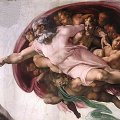 Get
Get  a high-quality picture of
Sistine Chapel, Book of Genesis, The Creation of Adam (Detail 2) for your computer or notebook. ‣
The Lord, borne aloft amidst a flight of angels, stands out
brightly against the shell of shadow of his huge purple mantle.
a high-quality picture of
Sistine Chapel, Book of Genesis, The Creation of Adam (Detail 2) for your computer or notebook. ‣
The Lord, borne aloft amidst a flight of angels, stands out
brightly against the shell of shadow of his huge purple mantle.
Sistine Chapel, Book of Genesis, The Creation of Adam (Detail 4) (1510)
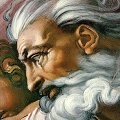 Get
Get  a high-quality picture of
Sistine Chapel, Book of Genesis, The Creation of Adam (Detail 4) for your computer or notebook. ‣
The adolescent face of Adam, seen in profile, still lacking a
definite expression, contrasts with the mature, intensely energetic
one of the Lord, with his grey hair and long beard streaming in the
air.
a high-quality picture of
Sistine Chapel, Book of Genesis, The Creation of Adam (Detail 4) for your computer or notebook. ‣
The adolescent face of Adam, seen in profile, still lacking a
definite expression, contrasts with the mature, intensely energetic
one of the Lord, with his grey hair and long beard streaming in the
air.
The Creation of Eve
Sistine Chapel, Book of Genesis, The Creation of Eve (Detail) (1510)
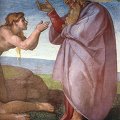 Get
Get  a high-quality picture of
Sistine Chapel, Book of Genesis, The Creation of Eve (Detail) for your computer or notebook. ‣
In response to the gesture and intense gaze of the Creator, Eve
appears to rise from the rocks behind Adam rather than from his body,
extending her joint hands.
a high-quality picture of
Sistine Chapel, Book of Genesis, The Creation of Eve (Detail) for your computer or notebook. ‣
In response to the gesture and intense gaze of the Creator, Eve
appears to rise from the rocks behind Adam rather than from his body,
extending her joint hands.
The Temptation and Expulsion
Sistine Chapel, Book of Genesis, The Fall and Expulsion from Garden of Eden (1510)
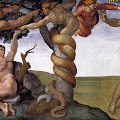 Get
Get  a high-quality picture of
Sistine Chapel, Book of Genesis, The Fall and Expulsion from Garden of Eden for your computer or notebook. ‣
The sixth scene in the chronological order of the narrative, The
Fall and Expulsion from Garden of Eden, is depicted in the large field
of the vault of the second bay, between the triangular spandrels.
a high-quality picture of
Sistine Chapel, Book of Genesis, The Fall and Expulsion from Garden of Eden for your computer or notebook. ‣
The sixth scene in the chronological order of the narrative, The
Fall and Expulsion from Garden of Eden, is depicted in the large field
of the vault of the second bay, between the triangular spandrels.
A bold and momentous step towards greater clarity was taken with the Fall of Adam and the Expulsion from the Garden of Eden. It has been noted that the composition's three pilasters, the fallen pair to the left, the pair expelled from Paradise to the right, and the anthropomorphized tree of knowledge with the female tempter in the centre (the Tree of Life before the Fall), join arms at the top to form the letter M in uncial script. Was this intended to be Michelangelo's signature? To the left, the profusion of the Garden of Eden is indicated by a few details, but even among these a barren stump thrusts up its branches beside the archetypal female. To the right, total desolation surrounds the human couple.
The rhythm of the whole composition flows from left to right. Eve grasps the apple boldly, Adam greedily, but in misfortune he seems greater than the woman. He knows that through his fall God, who was near to him, has become inaccessible and remote. He almost disdains the garden of which he feels no longer worthy. In spite of rocks and the barren tree stump, Eden - the term signifies bliss - is too voluptuous and full of delight; the bodies are too plump and smooth, the foliage above their heads is almost too luxuriant. It is as though Michelangelo meant to say: 'This is not yet the truth; that will have to be won in the desert of our destiny.' It is, moreover, striking that the cherub with the raised sword pointing the way out, although in flight and strongly foreshortened, appears a twin of the tempter and, like her, issues from the tree (the Tree of Life; the Cabalistic Sephiroth). Good and Evil have divided and become a dual power. This idea, like nearly every fresco on the vault of the Sistine, is full of mysteries which, we now realize, have their parallels in artistic and structural mysteries. Everything connects in Michelangelo's designs. In spite of their intellectual content, in spite of his humbly self taught knowledge, he never became literary; nor did he think in logical categories or in terms of dialectic, but visually and in symbols.
Sistine Chapel, Book of Genesis, The Fall and Expulsion from Garden of Eden (Detail) (1510)
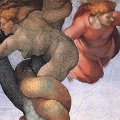 Get
Get  a high-quality picture of
Sistine Chapel, Book of Genesis, The Fall and Expulsion from Garden of Eden (Detail) for your computer or notebook. ‣
It is striking that the cherub with the raised sword pointing the
way out, although in flight and strongly foreshortened, appears a twin
of the tempter and, like her, issues from the tree (the Tree of
Life).
a high-quality picture of
Sistine Chapel, Book of Genesis, The Fall and Expulsion from Garden of Eden (Detail) for your computer or notebook. ‣
It is striking that the cherub with the raised sword pointing the
way out, although in flight and strongly foreshortened, appears a twin
of the tempter and, like her, issues from the tree (the Tree of
Life).
The Sacrifice of Noah
Sistine Chapel, Book of Genesis, The Sacrifice of Noah (1509)
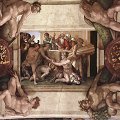 Get
Get  a high-quality picture of
Sistine Chapel, Book of Genesis, The Sacrifice of Noah for your computer or notebook. ‣
The seventh scene in the chronological order of the narrative, the
Sacrifice of Noah, is depicted in the centre of the vault of the third
bay, between two pairs of ignudi with medallions.
a high-quality picture of
Sistine Chapel, Book of Genesis, The Sacrifice of Noah for your computer or notebook. ‣
The seventh scene in the chronological order of the narrative, the
Sacrifice of Noah, is depicted in the centre of the vault of the third
bay, between two pairs of ignudi with medallions.
In the central panel, the composition of which is derived from those of classical reliefs, Noah celebrates the sacrifice on an altar seen cornerways on, assisted by other figures. In the chronological sequence of the biblical narration, the Sacrifice ought to follow and not precede the Deluge, but, apart from considerations relating to the typological interpretation of the scene, it is possible that Michelangelo preferred to reserve one of the largest panels in the ceiling for the Deluge.
The ignudi are painted with greater fluency and the modeling is more delicate than those of the first bay. Moreover, their poses are no longer wholly symmetrical. In fact, in the two figures on the left, only the lower part of the body is symmetrical, while the twisting of the bust and the head are expressions of contrapposto. The right arms of both are, however, extended toward the centre in order to hold the ribbon supporting the medallion. On the other hand, the ignudi on the right lean out toward the exterior, and the only difference between them appears to be the position of their arms.
Sistine Chapel, Book of Genesis, The Sacrifice of Noah (Detail) (1509)
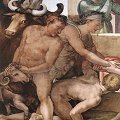 Get
Get  a high-quality picture of
Sistine Chapel, Book of Genesis, The Sacrifice of Noah (Detail) for your computer or notebook. ‣
The figures of the youth dragging the ram and the one taking the
viscera of the animals were painted by Domenico Carnevali around 1568,
after the original figures were lost as a result of the detachment of
the intonaco caused by instability in the structure of the wall.
a high-quality picture of
Sistine Chapel, Book of Genesis, The Sacrifice of Noah (Detail) for your computer or notebook. ‣
The figures of the youth dragging the ram and the one taking the
viscera of the animals were painted by Domenico Carnevali around 1568,
after the original figures were lost as a result of the detachment of
the intonaco caused by instability in the structure of the wall.
The work of assistants has been detected in the one of the youth on the left who, lighting the fire under the altar with a torch, shields his face from the heat with his hand.
Sistine Chapel, Book of Genesis, The Sacrifice of Noah (Detail 2) (1509)
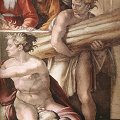 Get
Get  a high-quality picture of
Sistine Chapel, Book of Genesis, The Sacrifice of Noah (Detail 2) for your computer or notebook. ‣
During the recent restoration the work of assistants has been
detected in the figure of Noah's wife on the right, surrounded by
rigid outlines and modeled in a cursory manner.
a high-quality picture of
Sistine Chapel, Book of Genesis, The Sacrifice of Noah (Detail 2) for your computer or notebook. ‣
During the recent restoration the work of assistants has been
detected in the figure of Noah's wife on the right, surrounded by
rigid outlines and modeled in a cursory manner.
Sistine Chapel, Book of Genesis, The Sacrifice of Noah (Detail 3) (1509)
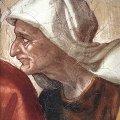 Get
Get  a high-quality picture of
Sistine Chapel, Book of Genesis, The Sacrifice of Noah (Detail 3) for your computer or notebook. ‣
The detail shows the head of Noah's wife.
a high-quality picture of
Sistine Chapel, Book of Genesis, The Sacrifice of Noah (Detail 3) for your computer or notebook. ‣
The detail shows the head of Noah's wife.
The Flood
Sistine Chapel, Book of Genesis, The Flood (Detail 3) (1509)
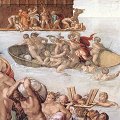 Get
Get  a high-quality picture of
Sistine Chapel, Book of Genesis, The Flood (Detail 3) for your computer or notebook. ‣
Those who have reached a boat that is about to capsize, between the
Ark and the hill in the foreground, are also engaged in a fierce
struggle. In the distance, the wicked, having reached the platform
surrounding the Ark, hurl themselves against the vessel from which
they have been excluded.
a high-quality picture of
Sistine Chapel, Book of Genesis, The Flood (Detail 3) for your computer or notebook. ‣
Those who have reached a boat that is about to capsize, between the
Ark and the hill in the foreground, are also engaged in a fierce
struggle. In the distance, the wicked, having reached the platform
surrounding the Ark, hurl themselves against the vessel from which
they have been excluded.
Drunkenness of Noah
Sistine Chapel, Book of Genesis, Drunkenness of Noah (Detail) (1509)
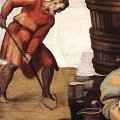 Get
Get  a high-quality picture of
Sistine Chapel, Book of Genesis, Drunkenness of Noah (Detail) for your computer or notebook. ‣
Saint Augustine was also responsible for the tradition that Noah's
planting of the vineyard - the scene depicted in the left background -
foreshadowed the incarnation of Christ.
a high-quality picture of
Sistine Chapel, Book of Genesis, Drunkenness of Noah (Detail) for your computer or notebook. ‣
Saint Augustine was also responsible for the tradition that Noah's
planting of the vineyard - the scene depicted in the left background -
foreshadowed the incarnation of Christ.
Sistine Chapel, Book of Genesis, Drunkenness of Noah (Detail 2) (1509)
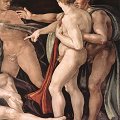 Get
Get  a high-quality picture of
Sistine Chapel, Book of Genesis, Drunkenness of Noah (Detail 2) for your computer or notebook. ‣
The detail shows the three sons of Noah: Ham, Shem, and Japeth.
a high-quality picture of
Sistine Chapel, Book of Genesis, Drunkenness of Noah (Detail 2) for your computer or notebook. ‣
The detail shows the three sons of Noah: Ham, Shem, and Japeth.
Sistine Chapel, Book of Genesis, Drunkenness of Noah (Detail 3) (1509)
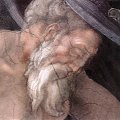 Get
Get  a high-quality picture of
Sistine Chapel, Book of Genesis, Drunkenness of Noah (Detail 3) for your computer or notebook. ‣
The detail shows the head of the drunken, sleeping Noah.
a high-quality picture of
Sistine Chapel, Book of Genesis, Drunkenness of Noah (Detail 3) for your computer or notebook. ‣
The detail shows the head of the drunken, sleeping Noah.
Quotes
Giorgio Vasari:
-
This work has been and truly is a beacon of our art, and it has
brought such benefit and enlightenment to the art of painting that it
was sufficient to illuminate a world which for so many hundreds of
years had remained in the state of darkness. And, to tell the truth,
anyone who is a painter no longer needs to concern himself about
seeing innovations and inventions, new ways of painting poses,
clothing on figures, and various awe-inspiring details, for
Michelangelo gave to this work all the perfection that can be given to
such details.
Goethe:
-
Without having seen the Sistine Chapel one can form no appreciable
idea of what one man is capable of achieving.
Werner Herzog:
-
Many years ago I went to the Vatican and looked at Michelangelo's
frescoes in the Sistine Chapel. I was overwhelmed with the feeling
that before Michelangelo no one had ever articulated and depicted
human pathos as he did in those paintings. Since then all of us have
understood ourselves just that little bit deeper, and for this reason
I truly feel his achievements are as great as the invention of
agriculture.
Michelangelo Art

|
|
More
Articles
 Art Encyclopedia A world history of art in articles.
Art Encyclopedia A world history of art in articles.
Renaissance
Michelangelo
Art, life and biography.
Michelangelo's David.
Michelangelo's Pieta.
Sistine Chapel. High Renaissance Masterpiece.
Sistine Chapel. Book of Genesis.
Sistine Chapel. The Ignudi.
Sistine Chapel. Seven Prophets.
Sistine Chapel. Five Sibyls.
Sistine Chapel. Lunettes.
Sistine Chapel. Pendentives.
Sistine Chapel. The Ancestors of Christ.
Sistine Chapel. The Last Judgement.
Art
 Art Wallpapers Art image collections for your desktop.
Art Wallpapers Art image collections for your desktop.
Della Francesca Art, $19
(95 pictures)
Da Vinci Art, $25
(80 pictures)
Michelangelo Art, $29
(180 pictures)
Raphael Art, $25
(125 pictures)
Titian Art, $29
(175 pictures)
Durer Art, $25
(120 pictures)

